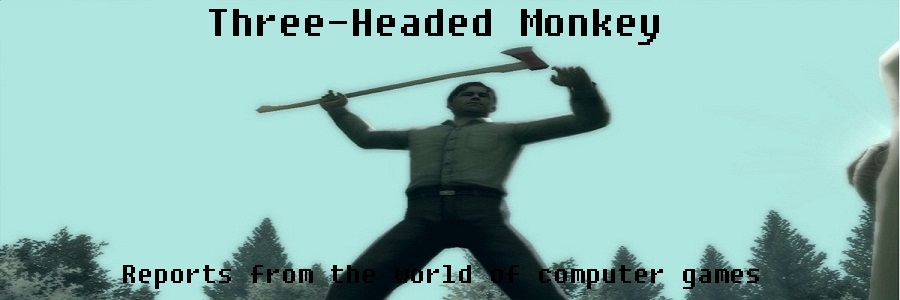Slave of God is a free
game whose unique visual presence seems to have inspired a few big games
websites to comment on it. Most notably RPS had an excellent guest article
written by Cara Ellison, who described the game in experiential terms as a kind
of expressionist depiction of a night club. This is pretty spot on and
therefore I would urge anyone interested in the game to first of all play it and
then read Ellison's article. And then, if the day seems to be leaving you with
nothing else, there's always me and this. Hi!
Slave of God is an
experimental short which not only excites through the immediacy of its visual
flare but also by its focus to provide a singular experience of a specific place
and environment. Comparable perhaps to what Proteus
is also doing, Slave of God has
picked a specific environment and developed its visual and audio style to
provide a contained sensory experience. A nightclub. Dance music, lights, colours,
rooms, bodies, and attraction.
The mixture here of expressive displays of colour, light and
music with the simple pixel forms of early computer gaming is what seems
immediately appealing to me. The uniform dancing figures are like Picasso's Three
Dancers digitised by a degraded, malfunctioning holodeck; silent individuals
line the dance floor - completely still, enrapt by the dancers, or devoid of
code. Bouncers also stand silently by, expressive in their simplicity - stocky,
mute and potentially aggressive. The game therefore doesn't so much present a
story as a familiar world of archetypes: the quiet one who sits alone, the
bouncer, the energetic dancers, the DJ, the bar staff. Each archetype fills
their place - disconcertingly silent, rigid and repetitive.
This place of solid, rhythmic archetypes is given fluidity
through the game's use of colour. Eurogamer simply went for "trippingballs simulator" which, to be fair, does no disservice. The inebriating
colours of a heavy acid trip are one the way of describing the game's twisting
visuals, however, the strangeness doesn't so much simply simulate
"tripping balls" as celebrate the whole club experience as one of wilful
disorientation and the pleasure of sensory excess.
The simple series of events which form the game's short
narrative draw on the almost instinctive nature of dancing and 'going out'. It's
the oldest story in the book (being meets other being, buys drinks, trips the
fuck out...), but Slave of God tells
it successfully almost entirely thanks to the hypnotic regularity of the
players actions.
You move into the club unaware of there being a 'story' so
much as compelled to do something -
this is a game after all. Seeing other humans - simple representations - you are
drawn towards them and as you get closer even your attraction is visualised
into a simple yet hypnotic set of lines telling you: here! Then love - or
something, a signifier. A drink. Follow your nose...where's the bar? Look at
the walls...there's the toilet. I know that symbol.
While the game's visuals are understandably confusing for
the player, the game itself - the game's narrative so to speak - talks in simple,
familiar terms: just look for the symbol. In this respect Slave of God speaks directly of computer games and their ability to
be both very simple and yet utterly compelling and communicative.



No comments:
Post a Comment